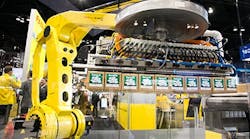Robots will never be “human,” but they’re developing like humans. Specifically, kindergarteners: They’re improving their mobility and hand-eye coordination, learning more quickly and starting to work well with others.
All of those things are making robots more useful on packaging lines.
The most common location for robots on a packaging line is at the end, especially palletizing. But as robots become smaller, faster, cheaper and more versatile, their potential uses in packaging are extending farther up the line.
Perhaps the most compelling adjective in that list is “cheaper.” Robots used to be an expensive, exotic, futuristic innovation; now they’re becoming close to an off-the-shelf commodity.
“The thing that we’re seeing is, it’s really allowed or has been attractive to smaller companies who have very little automation – certainly have no robots,” Selke says. “It’s allowed them an entry into beginning to automate some of their processes.”
Improvements in gripper technology, which have been going on for a while, are continuing to progress. This is partly a consequence of the expanded use of robots for all kinds of applications, especially agricultural. Grippers are being developed that can do things like twist strawberries off a stem without bruising them – applications that are now vital, with immigration crackdowns cutting into the pool of agricultural labor. This opens up the possibility of involving robots in handling primary packages, or even unpackaged products, directly, allowing them to move up the packaging line.
“We are seeing those robotic applications move upward within the lines, whether that is picking the actual food product,” Doyle says. “We’ve seen advances in technology, especially gripping technology, that are allowing a soft-type gripper that can pick a food product, whether it be a ball of dough or a head of lettuce or a tomato, that allows it to be picked off a line.”
On the move
Another development with packaging robots is mobility. As robots can be moved, or move themselves, around a plant floor, their flexibility and versatility greatly increase.
Flexibility has always been one of the biggest advantages of robotic palletizers; they can be programmed to assemble new pallet configurations much more easily than dedicated machines. ONExia takes that to a new level with the PalletizUR, a cobot from Universal Robots mounted on a skid that fits a forklift or pallet jack. As a cobot that does not require guarding, it takes up relatively little space, and being skid-mounted makes it easy to shift among packaging lines.
The PalletizUR from Onexia is a collaborative robot that loads pallets with a narrow footprint, on a skid-shaped base.
A step beyond portable robots like the PalletizUR are autonomous mobile robots (AMRs). These usually consist of a robot arm mounted on a platform big enough to hold a load of cases or other large packages.
AMRs have actually existed for more than a decade in a crude form, with the platform confined to a path delineated by a wire or other guide laid on or in the floor. But the new generation of AMRs use the same kind of technology used for driverless cars; in effect, they’re driverless forklifts.
Olympus Controls has done numerous projects that involve combining an AMR from MiR with a robot arm from Universal Robots, says Kevin Collins, Olympus Controls’ head of robotics business development. Although none of these has so far involved packaging lines, “I think it could be very useful on a packaging line," he says. End users could "combine the collaborative aspect with the picking and placing ability along with the material transport ability, so it can be an all-in-one solution.”
Robots have a lot of untapped potential for packaging lines. The key, Henry says, will be for line designers and integrators to recast their thinking to start with robots, rather than thinking of them as accessories or components of a packaging machine.
“I think that, for speeds to 200 parts per minute or so, robots could replace many packaging machines,” he says. “Someone will come along in the next two to three years and disrupt the industry.”


